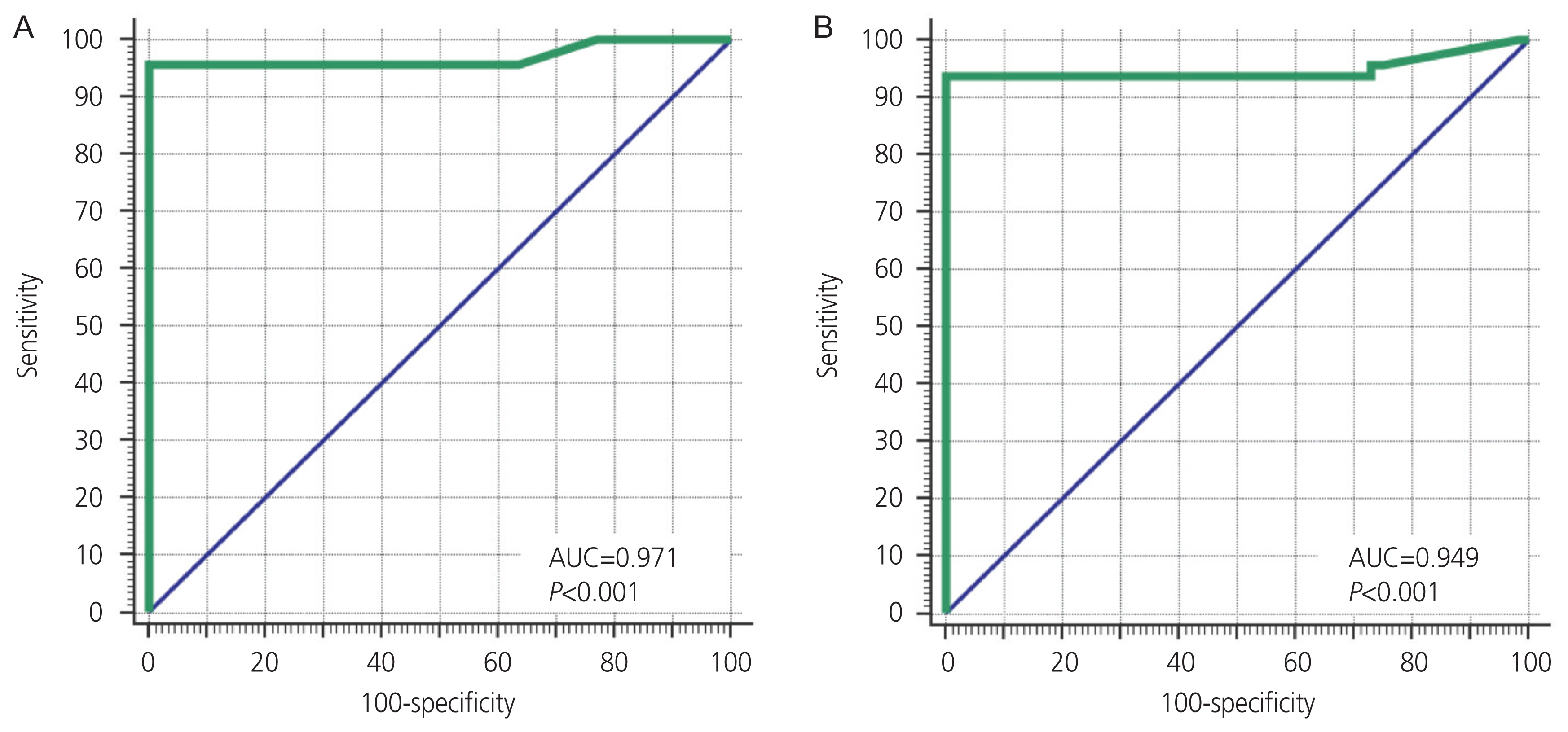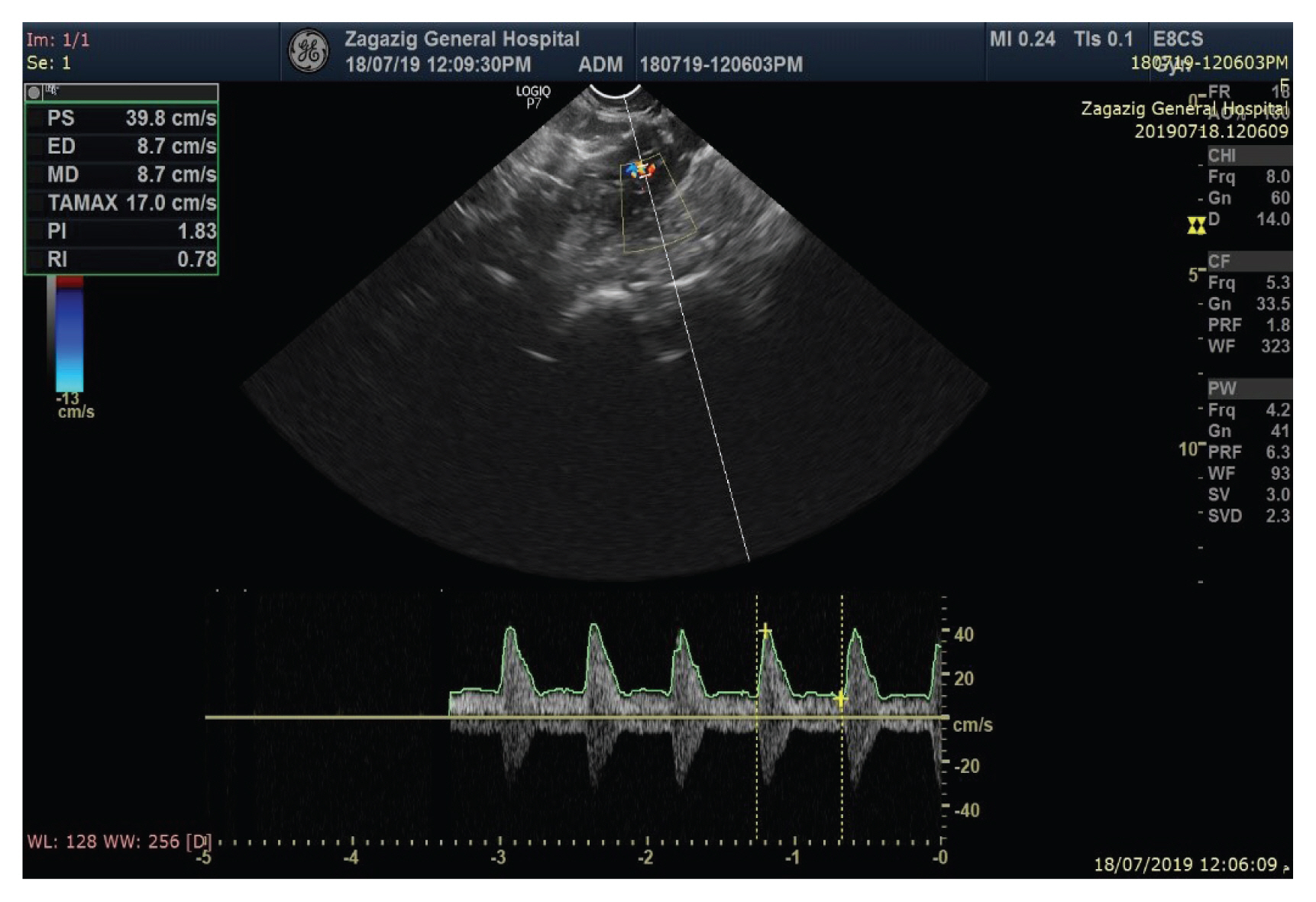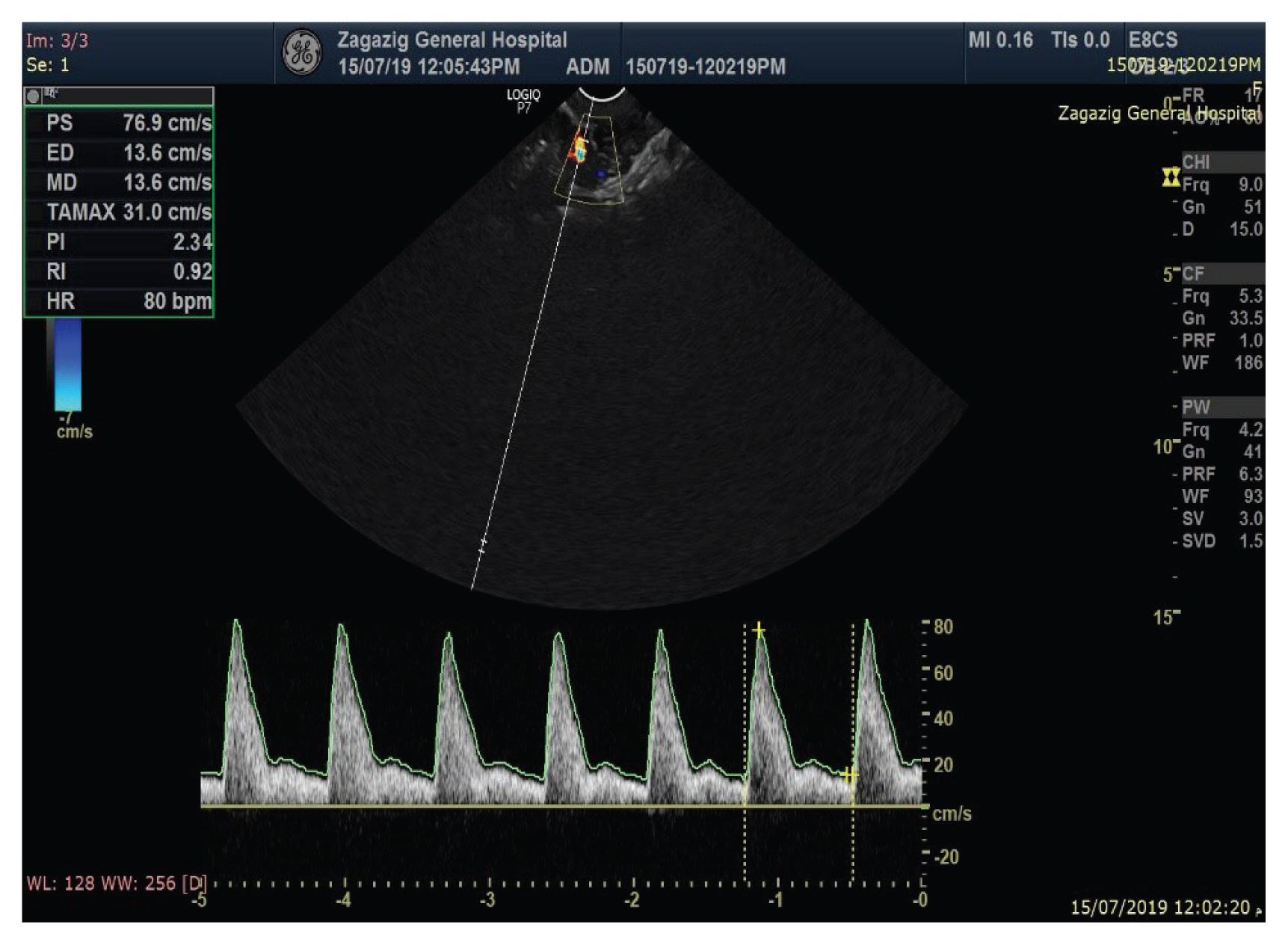Obstet Gynecol Sci.
2021 May;64(3):309-316. 10.5468/ogs.20349.
Uterine artery Doppler indices: pulsatility index and resistance index as predictive tools for the incidence of heavy menstrual bleeding related to copper intrauterine contraceptive device
- Affiliations
-
- 1Department of Obstetrics and Gynecology, Faculty of Medicine, Zagazig University, Zagazig, Egypt
- KMID: 2515983
- DOI: http://doi.org/10.5468/ogs.20349
Abstract
Objectives
To assess the predictive value of the initial uterine artery Doppler indices, the pulsatility index (PI), and resistance index (RI) in the prediction of heavy menstrual bleeding before and after copper intrauterine contraceptive device (IUCD) insertion.
Methods
The current prospective clinical study included 100 women who intended to use a copper IUCD (Cu T-380A) and met the inclusion criteria. Uterine artery Doppler PI and RI indices were calculated before IUCD insertion and at three and six months after insertion. Based on the presence or absence of menorrhagia, all women were classified into two groups: non-bleeding (n=52) and extreme menstrual bleeding (n=48). Receiver operating curve analysis was used to determine the predictive value of uterine artery PI and RI in patients with menorrhagia relevant to IUCD.
Results
The PI and RI indices displayed a highly significant difference between the IUCD groups at three and six months after insertion (P<0.001). Uterine artery PI ≤2.02 (sensitivity of 95.8%, specificity of 100%, and area below the curve [AUC] of 0.97 at P-value<0.001) and RI ≤0.83 (sensitivity of 93.8%, specificity of 100%, and AUC of 0.949 at P-value<0.001) were correlated with significant menstrual bleeding following insertion of IUCD.
Conclusion
The presented results confirmed our assumption that the initial studies of uterine artery Doppler can predict heavy-menstrual bleeding associated with IUCD and therefore, should be conducted in women pursuing reversible longacting contraception.
Keyword
Figure
Reference
-
References
1. Thiery M. Intrauterine contraception: from silver ring to intrauterine contraceptive implant. Eur J Obstet Gynecol Reprod Biol. 2000; 90:145–52.
Article2. Lin X, Wei M, Li TC, Huang Q, Huang D, Zhou F, et al. A comparison of intrauterine balloon, intrauterine contraceptive device and hyaluronic acid gel in the prevention of adhesion reformation following hysteroscopic surgery for Asherman syndrome: a cohort study. Eur J Obstet Gynecol Reprod Biol. 2013; 170:512–6.
Article3. Stoddard A, McNicholas C, Peipert JF. Efficacy and safety of long-acting reversible contraception. Drugs. 2011; 71:969–80.
Article4. Fadiloglu S, Dilbaz B, Fadiloglu E, Dilbaz S. Relationship between copper IUD complications and ultrasonographic findings. Arch Gynecol Obstet. 2018; 297:989–96.
Article5. Mutlu I, Demir A, Mutlu MF. Can uterine artery Doppler parameters predict copper intrauterine device-induced side effects? Eur J Contracept Reprod Health Care. 2013; 19:51–6.
Article6. Rezk M, Elkelani O, Gaber W, Shawky M. Pre-insertion uterine artery Doppler indices may predict intrauterine contraceptive device-related heavy menstrual bleeding. Middle East Fertil Soc J. 2018; 23:496–500.
Article7. Mohamed RS, Abdel Hakim SF. Uterine artery doppler as predictor of side effects in copper intrauterine device users. Al-Azhar Assiut Med J. 2015; 13:63–71.8. Larsson B. Reply to Drs. Salgo and Oster. Am J Obstet Gynecol. 1977; 128:921–2.
Article9. Gbarbea E. Contraception: past, present, and future [dissertation]. [Boston]: Boston University School of Medicine;2015. 1–58.10. Bioscientifica. Contraception: past, present, and future [Internet]. Bristol (UK): Bioscientifica;c2018. [cited 2018 May 10]. Available from: https://www.endocrine-abstracts.org/ea/0056/ea0056pl1.htm.11. Adeyemi-Fowode O, Bercaw-Pratt J. Intrauterine devices: effective contraception with noncontraceptive benefits for adolescents. J Pediatr Adolesc Gynecol. 2019; 32:S2–6.
Article12. Bousfield GR, May JV, Davis JS, Dias JA, Kumar TR. In vivo and in vitro impact of carbohydrate variation on human follicle-stimulating hormone function. Front Endocrinol (Lausanne). 2018; 9:216.
Article13. Fouda UM, Yossef D, Gaafar HM. Uterine artery blood flow in patients with copper intrauterine device-induced abnormal uterine bleeding. Middle East Fertil Soc J. 2010; 15:168–73.
Article14. Mansour GM, Hussein SH, Mohammed HF, El Mekkawy SF, Akl SA, Abd El Dayem AA. Can we predict menorrhagia with intrauterine contraceptive device (IUCD) insertion? Open J Obstet Gynecol. 2017; 7:753–66.
Article15. Järvelä I, Tekay A, Jouppila P. The effects of a copper-intrauterine device on the uterine artery blood flow in regularly menstruating women. Hum Reprod. 1998; 13:1841–5.16. El-Mazny A, Abou-Salem N, Elshenoufy H. Three-dimensional power Doppler study of endometrial and subendometrial microvascularization in women with intrauterine device-induced menorrhagia. Fertil Steril. 2013; 99:1912–57.
Article17. Jiménez MF, Arbo E, Vetori D, de Freitas FM, Cunha-Filho JSL. The effect of the levonorgestrel-releasing intrauterine system and the copper intrauterine device on subendometrial microvascularization and uterine artery blood flow. Fertil Steril. 2008; 90:1574–8.
Article
- Full Text Links
- Actions
-
Cited
- CITED
-
- Close
- Share
- Similar articles
-
- A case of cystolithiasis after intravesical migration of Copper T intrauterine device
- Comparison of Doppler Waveform Index in Benign and Malignant Ovarian Tumor
- Doppler Examination for the Differential Diagnosis of Pelvic Tumor (Pedunculated Subserosal Myoma versus Adnexal Mass)
- Uterine blood flow indices, antinuclear autoantibodies and unexplained recurrent miscarriage
- Current opinion on intrauterine device (IUD)





